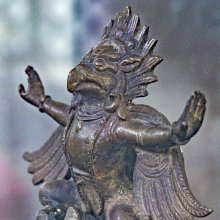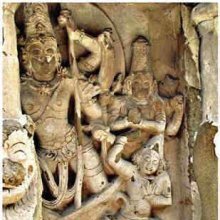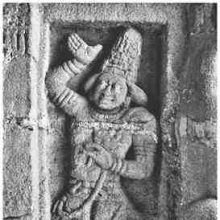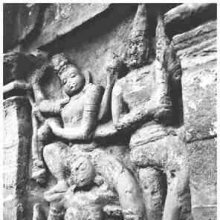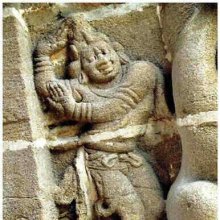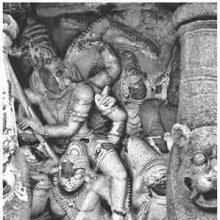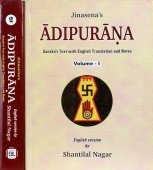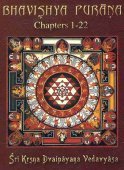Garuda, Garuḍa, Gāruḍa: 52 definitions
Introduction:
Garuda means something in Buddhism, Pali, Hinduism, Sanskrit, Jainism, Prakrit, the history of ancient India, Marathi, Hindi, biology. If you want to know the exact meaning, history, etymology or English translation of this term then check out the descriptions on this page. Add your comment or reference to a book if you want to contribute to this summary article.
Images (photo gallery)
(+68 more images available)
In Hinduism
Natyashastra (theatrics and dramaturgy)
Source: archive.org: The mirror of gesture (abhinaya-darpana)One of the saṃyutta-hastāni (Twenty-four combined Hands).—Garuḍa: Ardha-candra hands are held with palms askew, and the thumbs interlocked. Usage: Garuḍa.
Source: Shodhganga: The significance of the mūla-beras (natya)Garuḍa (गरुड) is one of the six divisions of sthānaka, one of the nine maṇḍala (postures of the feet) which in turn represents one of the four “movements of the feet” (pāda) according to the Abhinayadarpaṇa. Garuḍa-sthānaka (standing with ālīḍha-maṇḍala, then one knee placing on the ground while the two hands are held forming a circle) is not found in iconography.

Natyashastra (नाट्यशास्त्र, nāṭyaśāstra) refers to both the ancient Indian tradition (shastra) of performing arts, (natya—theatrics, drama, dance, music), as well as the name of a Sanskrit work dealing with these subjects. It also teaches the rules for composing Dramatic plays (nataka), construction and performance of Theater, and Poetic works (kavya).
Purana and Itihasa (epic history)
Source: Google Books: Cultural History from the Vāyu PurānaGaruḍa (गरुड)—Garutmat or Garuḍa had four wives, viz.
- Bhāsī,
- Krauñcī,
- Śukī
- and Dhṛtarāṣṭrī.
Śukī gave bbirth to sons who are the enemies of snakes who occupy various regions such as the Śālmali-dvīpa, and Devakūṭa and other mountains. Following are the progeny of Bhāsī: ulūkas, kākas, kukkuṭas, mayūras, kalaviṅkas, kapotas and lāvatittiras. Krauñcī gave birth to the vārdhīṇasas and the progeny of Dhṛtarāṣṭrī is as follows: haṃsas, kalahaṃsas, cakravākas and various other kinds of birds.
Garuḍa as the vehicle of Viṣṇu is also mentioned (Vāyu-purāṇa 97.22). Viṣṇu is called garuḍa-dhvaja and Śiva too is mentioned as the lord of Garuḍas. Garuḍa is the “consecrated lord” of the birds.
Source: archive.org: Puranic Encyclopedia1) Garuḍa (गरुड).—King of birds. Genealogy. Descended from Viṣṇu thus:—Brahmā -Marīci—Kaśyapa—Garuḍa. (See full article at Story of Garuḍa from the Puranic encyclopaedia by Vettam Mani)
2) Garuḍa (गरुड) or Garuḍavyūha refers to the “Disposition of an army in the shape of Garuḍa”.—Disposition of an army (vyūha) of four parts, (infantry, cavalry, elephants and chariots) in the battlefield, the arrangement of it, in various forms. It is said that during the period of Mahābhārata, there were various forms of disposition of the army.—Garuḍa-vyūha is mentioned in the Mahābhārata Bhīṣma Parva, Chapter 56.
Source: archive.org: Shiva Purana - English TranslationGaruḍa (गरुड), the chief of birds, is descended from Kaśyapa and Vinatā—one of the daughters of Dakṣa. He is the Vehicle of lord Viṣṇu. He is represented as having the head, wings, talons and beak of an eagle and the body and limbs of a man. His face is white, his wings red and his body golden. For details, sec Legends in the Mahābhārata PP. 1-153.
Source: Cologne Digital Sanskrit Dictionaries: The Purana Index1a) Garuḍa (गरुड).—(Garutmat)—a son of Tārkṣya (Kāśyapa) and Vinatā (Suparṇā), and vehicle of Hari.1 Has abode in Śālmalidvīpa.2 Took Kṛṣṇa to Madhuvana;3 Identified with Hari, and regarded as the embodiment of the Vedas.4 Attacked Asura followers of Bali, and knowing Hari's mind, he bound Bali with cords of Varuṇa.5 Serves as a watch for Kṣīroda. When he saw Bali carrying away Hari's crown-jewel, he pursued him and recovered it after a fight. When he saw on his return from Gomanta, he placed it on His head and belauded him, requesting him for opportunities of service to Him, who ordered him to go back and come whenever He thought of him.6 His winning nectar is compared to Kṛṣṇa winning Vaidarbhī in svayaṃvara.7 Kālīya, the enemy of snakes, freed from fear of; entered into an agreement with snakes of Ramaṇaka to give him bali every fortnight. Kālīya failed to do this, and after a fight escaped to the river Kālindī where Garuḍa could not go, as he was under a curse. It happened once that Garuḍa took a kingfish from the river against the wish of the sage Saubhari who cursed that Garuḍa's coming again there would mean the end of his life.8 Attacked by Mura,9 killed all elephants of Naraka,10 carried Kṛṣṇa to Indra's city. Defeated Varuṇa attacking Kṛṣṇa, flung Śiva and his bull to a distance of a hundred dhanus. Discomfited Airāvata of Indra, and took Kṛṣṇa and Satyabhāmā safely to Dvārakā.11 Garuḍa standard of Hari.12 Praise of Hari.13 Took nectar for mother's sake to Somaka hill of Plakṣa; married five daughters of Tāmra and became father of birds in all the world.14 Younger brother of Aruṇa.15 Worship of, on the Bhīmadvādaśi, and in the Lakṣa homa of Grahabali. Icon of.16 In the Tārakāmaya: in the war with Kālanemī: performed tapas at Kanakhala.17 had a number of wives, sons and grandsons; the eater of all cruel snakes—his descendants spread over largely the whole of Śālmalidvīpa, and the mountains Devakūṭa, Maṇimanta, Sahasraśikhara, Parnamala, Sukeśa, and Sataśruga, the five-peaked Kauraja, Hemakūṭa etc.18
- 1) Bhāgavata-purāṇa VI. 6. 22: III. 19. 11. Brahmāṇḍa-purāṇa III. 7. 29: 8. 11. Matsya-purāṇa 6. 34: 146. 22. Vāyu-purāṇa 49. 10; 69. 66: 70. 11: 72. 45. Viṣṇu-purāṇa I. 21. 18.
- 2) Bhāgavata-purāṇa V. 20. 8.
- 3) Ib. IV. 9. 1.
- 4) Ib. VI 8. 29. VIII. 3. 31.
- 5) Ib. VIII. 21. 16 and 26.
- 6) Ib. X. 53 (V) 10-19.
- 7) Ib. X. 52. 17.
- 8) Ib. 16. 63; 17. 1-11. Viṣṇu-purāṇa V. 7. 78.
- 9) Bhāgavata-purāṇa X. 59. 7-8.
- 10) Ib. 59. 19. Viṣṇu-purāṇa V. 29. 14.
- 11) Bhāgavata-purāṇa 65 (V) 1: 66 (V) 22-25, 48; 67 (V) 11-14, 38-39, Matsya-purāṇa 150. 219 Viṣṇu-purāṇa V. 30. 64-70. XI. 30. 44.
- 12) Brahmāṇḍa-purāṇa III. 71. 248.
- 13) Bhāgavata-purāṇa IV. 30. 6. XI. 27. 28.
- 14) Brahmāṇḍa-purāṇa II. 19. 11-12: III. 7. 448-51: Matsya-purāṇa 122. 15.
- 15) Matsya-purāṇa 150-53.
- 16) Matsya-purāṇa 53. 41; 69. 26; 93. 99: 258. 11 and 12.
- 17) Matsya-purāṇa 152. 6-7, 36: 153. 181: 171. 50: 178. 32 and 50: 193. 70: 249. 35
- 18) Vāyu-purāṇa 69. 328-335.
1b) A son of Viśveśā.*
- * Matsya-purāṇa 171. 50.
2) Gāruḍa (गारुड).—The Purāṇa of 19000 verses narrated by Kṛṣṇa in the Gāruḍa kalpa; the origin of Garuḍa from the mundane egg; a gift of, takes one to Śiva loka, see Gāruḍa Purāṇa.*
- * Matsya-purāṇa 53. 53-4.
Garuḍa (गरुड) is a name mentioned in the Mahābhārata (cf. I.27, I.28, I.29, I.31, I.59.39, I.65) and represents one of the many proper names used for people and places. Note: The Mahābhārata (mentioning Garuḍa) is a Sanskrit epic poem consisting of 100,000 ślokas (metrical verses) and is over 2000 years old.
Source: Shodhganga: The saurapurana - a critical studyGaruḍa (गरुड) refers to one of the sons of Vinatā: one of thirteen of Dakṣa’s sixty daughters given to Kaśyapa in marriage, according to one account of Vaṃśa (‘genealogical description’) of the 10th century Saurapurāṇa: one of the various Upapurāṇas depicting Śaivism.—Accordingly, Dakṣa gets married to Asikni, the daughter of Prajāpati Viraṇa and begot sixty daughters [viz., Kaśyapa]. Kaśyapa’s thirteen wives are [viz., Vinatā]. Vinatā became the mother of Garuḍa and Aruṇa.

The Purana (पुराण, purāṇas) refers to Sanskrit literature preserving ancient India’s vast cultural history, including historical legends, religious ceremonies, various arts and sciences. The eighteen mahapuranas total over 400,000 shlokas (metrical couplets) and date to at least several centuries BCE.
Pancaratra (worship of Nārāyaṇa)
Source: SriMatham: Vaiṣṇava Iconology based on Pañcarātra ĀgamaLord Vishnu’s vehicle is Garuda which means ‘Wings-of-speech,’ in the Vedas he is also known as Garutman. He represents the Vedas which carry the Lord of Sacrifices. Garuda is the mantras of the Veda which travel with the speed of light from one world to another.
Garuda is also taken as the personification of courage (Satapatha Brahmana 6;7;2;6.)
According to the Puranas, Garuda is the son of Kaśyapa (vision) and Vinata (She-before-whom-knowledge-bows).
Garuda’s wife is Unnati (progress) also called Vināyakā (queen-of-knowledge). He has six sons;
- Summukha (Beautiful-face),
- Sunāma (Beautiful-name),
- Sunetra (Beautiful eyes),
- Suvarcas (Beautiful vigour),
- Suruk (Beautiful brightness)
- and Subala (Beautiful strength).
Garuḍa (गरुड) refers to the “king of birds” and is the son of Vinatā, according to the Viṣvaksena Samhitā (verse 26.61) which mentions the efficacy of the Garuḍa-mantra by paying obeisance to him.—It mentions that Garuḍa also renowned as Suparṇa, the king of birds and the illustrious son of Vinatā, is adorned by the eight divine serpents residing in the seven nether-worlds; his body is smeared with the blood of serpents he has slain. Garuḍa is eulogised as the vehicle of Viṣṇu, who can make the three worlds tremble with his primal strength, and who conquered Brahmā and the other gods (and brought the nectar) to free his mother from bondage:

Pancaratra (पाञ्चरात्र, pāñcarātra) represents a tradition of Hinduism where Narayana is revered and worshipped. Closeley related to Vaishnavism, the Pancaratra literature includes various Agamas and tantras incorporating many Vaishnava philosophies.
Shilpashastra (iconography)
Source: archive.org: Illustrations of Indian Music and Dance in Western Indian StyleGāruḍa (गारुड) refers to one of the forty-seven tānas (tone) used in Indian music.—The illustration of Gāruḍa (as a deity) according to 15th-century Indian art is as follows.—The colour of his body is yellow. His face is similar to the face of a bull. His right hand is in Pravacana-Mūdra and a viṇā is in his left hand.
The illustrations (of, for example Gāruḍa) are found scattered throughout ancient Jain manuscripts from Gujarat. The descriptions of these illustrations of this citrāvalī are based on the ślokas of Vācanācārya Gaṇi Sudhākalaśa’s Saṅgītopaniṣatsāroddhāra (14th century) and Śārṅgadeva’s Saṅgītaratnākara (13th century).
Source: Red Zambala: Hindu Icons and Symbols | TrinityGaruḍa (Viṣṇu’s vehicle).—Viṣṇu rides upon a creature half-human & half-eagle known as Garuḍa or Garutman which means “wings-of-speech”. Garuda in the mythical and colourful Hindu scriptures is the King of the Birds and acts as messenger between Gods and Humans. He is the manifestation of the triple Vedas.
Garuḍa is depicted as the mortal enemy of snakes — he thus represents courage. Snakes represent all those factors that obstruct the spiritual path. His wife's name is Unnati or “progress” also called “queen-of-knowledge”.
Source: Archaeological Survey of India: Śaiva monuments at Paṭṭadakal (śilpa)Garuḍa (गरुड) is depicted as a sculpture on the fourth pillar of the southern half of the maṇḍapa of the temple of Lokeśvara.—Garuḍa is shown at the extreme right end of the panel. He first fights with a serpent and then there are series of divine beings including Indra on his elephant, Yama on the buffalo. After facing all these hurdles, Garuḍa reaches the spot where the nectar is kept. At the extreme left of the panel is shown Viśvakarman surrounded by flames. In the Mahābhārata, it is told that Garuḍa took the form of a being with hundred and eight mouths. He extinguished the fire by spitting water on the fire from his hundred and eight mouths. (Mahābhārata, Ādiparvan, adhyāya 32). But in the image under study, Garuḍa is shown pouring water from a pot on the fire.
Source: Shodhganga: The significance of the mūla-beras (śilpa)1) Garuḍa (गरुड) is the name of animal (Brahminy kite, Haliastur indus) representing one of the several “attributes” (āyudha) or “accessories” of a detiy commonly seen depicted in Hindu iconography, defined according to texts dealing with śilpa (arts and crafs), known as śilpaśāstras.—The śilpa texts have classified the various accessories under the broad heading of āyudha or karuvi (implement), including even flowers, animals, and musical instruments. The animals and birds found as vehicles for the deities or held as attributes or weapons in the hands of the deities are, for example, Garuḍa.
2) Garuḍa (गरुड) is the name of a deity depicted at the Ulagalantha Perumal Temple in Kanchipuram (Kāñcīpuram), representing a sacred place for the worship of Viṣṇu.—Garuḍa is found in samabhaṅga posture with hands in añjali-hasta.
Garuḍa is also depicted at the Andal Temple in Srivilliputtur (Villiputtur or Thiruvilliputtur), representing a sacred place for the worship of The Goddess (Devī).—Garuḍa, the vehicle of Viṣṇu, is found to the left of Raṅgamannar. Garuḍa is represented in standing posture in samabhaṅga. His two hands are in añjali, as if paying salutation to the divine couple Raṅgamannar and Āṇṭāl. In front of the mūla-bera, the utsava-mūrti of Raṅgamannar, Āṇṭāl and Garuḍa is found. To the right of the main sanctum Āndāl and Raṅgamannar are seen in the same postures as described in the case of the mūla bera earlier.

Shilpashastra (शिल्पशास्त्र, śilpaśāstra) represents the ancient Indian science (shastra) of creative arts (shilpa) such as sculpture, iconography and painting. Closely related to Vastushastra (architecture), they often share the same literature.
Vastushastra (architecture)
Source: Wisdom Library: Vāstu-śāstraGaruḍa (गरुड):—The Sanskrit name for a classification of a ‘temple’, according to the 2nd century Matsyapurāṇa and the Viśvakarmaprakāśa, both featuring a list of 20 temple types. In the Viśvakarmaprakāśa, the name for this temple category is Suparṇa. This list represents the classification of temples in South-India.
Garuḍa is also mentioned in a list from the Samarāṅgaṇasūtradhāra chapter 56, in the first the group named Lalita (containing 25 unique temple varieties) and in the second the group named Sāndhāra (containing 25 unique temple varieties).
Garuḍa is found in another list in the Samarāṅgaṇasūtradhāra, chapter 63, where it is listed in the group named Nāgara, containing 20 different prāsādas (temples/buildings).
Garuḍa is also listed in the Agnipurāṇa which features a list of 45 temple types. It is listed under the group named Maṇika, featuring oval-shaped temples. This list represents a classification of temples in Nort-India.
Source: Shodhganga: Elements of Art and Architecture in the Trtiyakhanda of the Visnudharmottarapurana (vastu)Garuḍa (गरुड) refers to one of the hundred types of Temples (in ancient Indian architecture), according to the Viṣṇudharmottarapurāṇa, an ancient Sanskrit text which (being encyclopedic in nature) deals with a variety of cultural topics such as arts, architecture, music, grammar and astronomy.—It is quite difficult to say about a definite number of varieties of Hindu temples but in the Viṣṇudharmottarapurāṇa hundred varieties of temples have been enumerated. For example, Garuḍa. These temples are classified according to the particular shape, amount of storeys and other common elements, such as the number of pavilions, doors and roofs.

Vastushastra (वास्तुशास्त्र, vāstuśāstra) refers to the ancient Indian science (shastra) of architecture (vastu), dealing with topics such architecture, sculpture, town-building, fort building and various other constructions. Vastu also deals with the philosophy of the architectural relation with the cosmic universe.
Vaishnavism (Vaishava dharma)
Source: ISKCON Press: GlossaryGaruḍa (गरुड).—Lord Viṣṇu's eternal carrier, a great devotee, the son of Aditi and Kaśyapa who takes the form of an eagle and is the bird carrier of Lord Viṣṇu. He is often found atop a pole facing the entrance of Viṣṇu temples. The emblem of Garuḍa is always on the chariot of Lord Kṛṣṇa.
Source: Pure Bhakti: Brhad BhagavatamrtamGaruḍa (गरुड) refers to:—Śrī Viṣṇu’s eternal carrier who takes the form of an eagle; the son of Vinatā and Kaśyapa. (cf. Glossary page from Śrī Bṛhad-bhāgavatāmṛta).

Vaishnava (वैष्णव, vaiṣṇava) or vaishnavism (vaiṣṇavism) represents a tradition of Hinduism worshipping Vishnu as the supreme Lord. Similar to the Shaktism and Shaivism traditions, Vaishnavism also developed as an individual movement, famous for its exposition of the dashavatara (‘ten avatars of Vishnu’).
Kavya (poetry)
Source: Wisdom Library: KathāsaritsāgaraGaruḍa (गरुड) is the “king of the birds”, and mentioned as the son of Vinatā (one of the two wives of Kaśyapa), according to a story called “the dispute about the colour of the sun’s horses” in the Kathāsaritsāgara, chapter 22.
The Kathāsaritsāgara (‘ocean of streams of story’), mentioning Garuḍa, is a famous Sanskrit epic story revolving around prince Naravāhanadatta and his quest to become the emperor of the vidyādharas (celestial beings). The work is said to have been an adaptation of Guṇāḍhya’s Bṛhatkathā consisting of 100,000 verses, which in turn is part of a larger work containing 700,000 verses.
Source: archive.org: The ocean of story, vol. 1The Garuḍa bird is the vehicle of Viṣṇu. It is described as half-man and half-bird, having the head, wings, beak and talons of an eagle, and human body and limbs, its face being white, its wings red and its body golden.
Garuḍa is the son of one of the daughters of Dakṣa. The account of its miraculous birth and how it became the vehicle of Viṣṇu is given at the beginning of the Mahābhārata (I, xvi). Other adventures in its life, such as the attempt to stop Rāvaṇa from abducting Sītā, are described in the Rāmāyaṇa and the Viṣṇu Purāṇa.

Kavya (काव्य, kavya) refers to Sanskrit poetry, a popular ancient Indian tradition of literature. There have been many Sanskrit poets over the ages, hailing from ancient India and beyond. This topic includes mahakavya, or ‘epic poetry’ and natya, or ‘dramatic poetry’.
Shaivism (Shaiva philosophy)
Source: Shodhganga: Mantra-sādhana: Chapter One of the KakṣapuṭatantraGāruḍa (गारुड) is the name of an Āgama or Tantra mentioned in the Kakṣapuṭatantra verse 1.5-7.—“At a previous time, when Pārvatī asked him, Śaṅkara told of the attainments of vidyā in the wide worldly life, in various ways. I observed each teaching taught also by the troops of Gods, Siddhas (those who have attained supernatural power), Munis (saints), Deśikas (spiritual teachers), and Sādhakas (tantric practicioners). They are [, for example]: Gāruḍa... I shall carefully extract all the above-mentioned āgamas, which are transmitted from mouth to mouth, like butter extracted from coagulated milk”.
Source: Shodhganga: Iconographical representations of ŚivaGāruḍa (गारुड) or Gāruḍāgama refers to one of upāgamas (supplementary scriptures) of the Kiraṇāgama which is one of the twenty-eight Siddhāntāgama: a classification of the Śaiva division of Śaivāgamas. The Śaivāgamas represent the wisdom that has come down from lord Śiva, received by Pārvatī and accepted by Viṣṇu. The purpose of revealing upāgamas (e.g., Gāruḍa Āgama) is to explain more elaborately than that of mūlāgamas (e.g., Kiraṇa-āgama) and to include any new idea if not dealt in mūlāgamas.

Shaiva (शैव, śaiva) or Shaivism (śaivism) represents a tradition of Hinduism worshiping Shiva as the supreme being. Closely related to Shaktism, Shaiva literature includes a range of scriptures, including Tantras, while the root of this tradition may be traced back to the ancient Vedas.
Ayurveda (science of life)
Veterinary Medicine (The study and treatment of Animals)
Source: Shodhganga: Portrayal of Animal Kingdom (Tiryaks) in Epics An Analytical study1) Garuḍa (गरुड) refers to the Ring-tailed fishing eagle (Haliaeetus leucoryphus), according to scientific texts such as the Mṛgapakṣiśāstra (Mriga-pakshi-shastra) or “the ancient Indian science of animals and birds” by Hamsadeva, containing the varieties and descriptions of the animals and birds seen in the Sanskrit Epics such as the Ramayana and Mahabharata.
2) Garuḍa (गरुड) also refers to the White-bellied sea eagle (Haliacetus leucogaster).

Āyurveda (आयुर्वेद, ayurveda) is a branch of Indian science dealing with medicine, herbalism, taxology, anatomy, surgery, alchemy and related topics. Traditional practice of Āyurveda in ancient India dates back to at least the first millenium BC. Literature is commonly written in Sanskrit using various poetic metres.
Nirukta (Sanskrit etymology)
Source: Shodhganga: Kasyapa Samhita—Text on Visha Chikitsa (nirukta)1) Garuḍa (गरुड) (also reckoned as Suparṇa, Garutmān and Vainateya) holds a place of pride in Indian religion. As to the etymology of the word Garuḍa, the Śabdakalpadruma (p. 309) states: garut+ḍī+ḍaḥ, that which flies with its wings—garuḍābhyām pakṣābhyām ḍayate uḍḍayate iti garuḍah.
2) Another derivation of Garuḍa is: gṛ+uḍaca—the swallower or devourer. Kṣīrasvamin, commentator of the Amarakoṣa, while giving the synonyms states, garuḍābhir ḍayate (one who flies with wings); garutmān is garut+matup, one who possesses wings. Garutmān is also referred to as the mighty, powerful and heavy—guru+ ātman.
4) The term ‘garuḍa’ is derived from gara + the root ‘ad’, meaning one who consumes poison.
5) Garuḍa could also be derived as—‘gara’ and the causal form of ‘uḍ’ + root ‘ḍi’, meaning one who removes poison—garam + uḍāyati.
Nirukta (निरुक्त) or “etymology” refers to the linguistic analysis of the Sanskrit language. This branch studies the interpretation of common and ancient words and explains them in their proper context. Nirukta is one of the six additional sciences (vedanga) to be studied along with the Vedas.
General definition (in Hinduism)
Source: escholarship: Gāruḍa Medicine: A History of Snakebite and Religious Healing in South AsiaGāruḍa (गारुड) medicine;—The method of treating envenomation and poisoning with mantra systems and herbal or mineral cures expounded in the Gāruda Tantras.
In Buddhism
Mahayana (major branch of Buddhism)
Source: Wisdom Library: Maha Prajnaparamita SastraGaruḍa (गरुड) refers to “golden-winged birds” and represents an incarnation destination of the tiryaggati (animal realm) according to the “world of transmigration” section in the 2nd century Mahāprajñāpāramitāśāstra (chapter XXVII).—The Bodhisattva sees the animals (tiryak) undergoing all the torments: they are made to gallop by blows of the whip or stick; they are made to make long journeys carrying burdens; their harness is damaged; they are branded with hot iron. Very generous (mahātyāgin), if they have tormented beings by their arrogance (cittonnati) and their tyranny (darpa), they take the form of [for example], a golden-winged bird (garuḍa).
According to the 2nd century Mahāprajñāpāramitāśāstra (chapter XX), “when the Bodhisattva cultivates generosity (dāna),... He knows that a proud man, but one who practices generosity even though it be ostentatiously (abhimāna), is reborn among the golden-winged birds (garuḍa), where he will always have power (aiśvarya), possess the philopher’s stone (cintāmaṇi) in place of a ring (keyūra), succeed in having all his needs satisfied, suffer nothing contrary to his wishes, and can manage everything”.
Source: archive.org: Bulletin of the French School of the Far East (volume 5)Garuḍa (गरुड) [?] (in Chinese: Kia-leou-tch'a) is the name of an ancient kingdom associated with Viśākhā or Viśākhānakṣatra, as mentioned in chapter 18 of the Candragarbha: the 55th section of the Mahāsaṃnipāta-sūtra, a large compilation of Sūtras (texts) in Mahāyāna Buddhism partly available in Sanskrit, Tibetan and Chinese.—Chapter 18 deals with geographical astrology and, in conversation with Brahmarāja and others, Buddha explains how he entrusts the Nakṣatras [e.g., Garuḍa] with a group of kingdoms [e.g., Ṣavara] for the sake of protection and prosperity.
Garuḍa (गरुड) is also the name of an ancient kingdom associated with Kṛttikā or Kṛttikānakṣatra.

Mahayana (महायान, mahāyāna) is a major branch of Buddhism focusing on the path of a Bodhisattva (spiritual aspirants/ enlightened beings). Extant literature is vast and primarely composed in the Sanskrit language. There are many sūtras of which some of the earliest are the various Prajñāpāramitā sūtras.
Tibetan Buddhism (Vajrayana or tantric Buddhism)
Source: academia.edu: The Structure and Meanings of the Heruka MaṇḍalaGaruḍa (गरुड) is the name of a Vīra (hero) who, together with the Ḍākinī named Garuḍī forms one of the 36 pairs situated in the Vāyucakra, according to the 10th century Ḍākārṇava chapter 15. Accordingly, the vāyucakra refers to one of the three divisions of the dharma-puṭa (‘dharma layer’), situated in the Herukamaṇḍala. The 36 pairs of Ḍākinīs and Vīras [viz., Garuḍa] are dark blue in color; they each have one face and four arms; they hold a skull bowl, a skull staff, a small drum, and a knife.

Tibetan Buddhism includes schools such as Nyingma, Kadampa, Kagyu and Gelug. Their primary canon of literature is divided in two broad categories: The Kangyur, which consists of Buddha’s words, and the Tengyur, which includes commentaries from various sources. Esotericism and tantra techniques (vajrayāna) are collected indepently.
General definition (in Buddhism)
Source: Wisdom Library: BuddhismGaruda:—A giant Bird who eats dragons. Some Indian deities rode them.
In Jainism
General definition (in Jainism)
Source: archive.org: The Jaina IconographyGaruḍa (गरुड) or Kiṃpuruṣa is the name of the Yakṣa accompanying Śāntinātha: the sixteenth of twenty-four Tīrthaṃkaras or Jinas, commonly depicted in Jaina iconography.—The cognizance which separates the image of Śāntinātha from those of other Tīrthaṃkaras is a deer. The Yakṣa and Yakṣiṇī attendants escorting him are respectively named as Kiṃpuruṣa and Mahāmānasī (Śvetāmbara: Garuḍa and Nirvāṇī). Rājā Puruṣadatta stands for his Chowri-bearer. The tree under which he attained the Kevala knowledge is Nandi Vṛkṣa.
Garuḍa Yakṣa is represented from both points of view as riding a boar. (according to the Pravacana-Sāroddhāra and elephant according to Hemacandra) and as endowed with four hands. The objects borne by the hands, as usual, vary canonically. In accordance with the Śvetāmbara view, the hands hold a citrus, lotus, mongoose and rosary. To the other sect the hands are known to have a lotus, fruit, Vajra and discus.
Source: archive.org: TrisastisalakapurusacaritraGaruḍa (गरुड) is the name of the Yakṣa (i.e., Śāsanadevatās or ‘messenger-deities’) associated with Śānti-nātha, according to chapter 5.4 [śāntinātha-caritra] of Hemacandra’s 11th century Triṣaṣṭiśalākāpuruṣacaritra: an ancient Sanskrit epic poem narrating the history and legends of sixty-three illustrious persons in Jainism.
Accordingly:—“Originating in that congregation, the Yakṣa Garuḍa, black, whose vehicle was an elephant, boar-faced, whose two right hands held a citron and a lotus, whose two left hands held an ichneumon and a rosary, became Śrī Śānti Svāmin’s messenger-deity. Originating in that congregation, Nirvāṇi, fair-bodied, with a lotus-seat, her two right hands holding a book and a blue lotus, her two left ones a water-jar and lotus, also became the messenger-deity of the Lord of the World”.

Jainism is an Indian religion of Dharma whose doctrine revolves around harmlessness (ahimsa) towards every living being. The two major branches (Digambara and Svetambara) of Jainism stimulate self-control (or, shramana, ‘self-reliance’) and spiritual development through a path of peace for the soul to progess to the ultimate goal.
India history and geography
Source: Cologne Digital Sanskrit Dictionaries: Indian Epigraphical GlossaryGaruḍa.—(IA 20), the royal eagle; the white kite (in areas like Bihar and Madras). Note: garuḍa is defined in the “Indian epigraphical glossary” as it can be found on ancient inscriptions commonly written in Sanskrit, Prakrit or Dravidian languages.
Source: Mandala Texts: Yakchoe: The Grand Festival of Ura VillageGaruḍa is the second dance-component of the Chana Dorje performance of the Yakchoe festival celebrated in the village Ura Makrong in Bhutan.—The set of dances depicting the Chana Dorje maṇḍala and the associated spiritual practices is the main ceremony of Ura Yakchoe, and is unique to this festival. [...] Nyulema (or Zhawri) is followed by the dance of four Garuḍa, which represent spiritual forces emanating from the figure of Chana Dorje [...]
Source: Academia: Ritual Period: A Comparative Study of Three Newar Buddhist Menarche ManualsGaruda (गरुद) refers to a class of deities, according to the “Vādhā byaṃ ke vidhi”: the name of two manuscripts written by (1) Kathmandu-based priest, Badriratna Bajracharya and (2) Buddharatna Bajracharya from Lalitpur.—Badriratna’s text pays the most attention to the invocations of celestial bodies and other cosmologically grouped agents. The list consists of [e.g., garudas]. In this list, we particularly find the dark forces that are especially adept at causing problems for women, children and, more specifically, girl children, addressed and harnessed.

The history of India traces the identification of countries, villages, towns and other regions of India, as well as mythology, zoology, royal dynasties, rulers, tribes, local festivities and traditions and regional languages. Ancient India enjoyed religious freedom and encourages the path of Dharma, a concept common to Buddhism, Hinduism, and Jainism.
Biology (plants and animals)
Source: Wisdom Library: Local Names of Plants and DrugsGaruda in the Sanskrit language is the name of a plant identified with Oryza sativa L. from the Poaceae (Grass) family. For the possible medicinal usage of garuda, you can check this page for potential sources and references, although be aware that any some or none of the side-effects may not be mentioned here, wether they be harmful or beneficial to health.
Source: Google Books: CRC World Dictionary (Regional names)Garuda in India is the name of a plant defined with Oryza sativa in various botanical sources. This page contains potential references in Ayurveda, modern medicine, and other folk traditions or local practices It has the synonym Oryza sativa subsp. indica Kato (among others).
Example references for further research on medicinal uses or toxicity (see latin names for full list):
· Cytologia (1991)
· Plant Systematics and Evolution (1993)
· Proceedings of the Indian Science Congress Association (1987)
· Proceedings of the Indian National Science Academy. Part B, Biological Sciences (1989)
· Bulletin de la Société d’Histoire Naturelle d’Autun (1895)
· Species Plantarum (1753)
If you are looking for specific details regarding Garuda, for example health benefits, diet and recipes, pregnancy safety, chemical composition, extract dosage, side effects, have a look at these references.

This sections includes definitions from the five kingdoms of living things: Animals, Plants, Fungi, Protists and Monera. It will include both the official binomial nomenclature (scientific names usually in Latin) as well as regional spellings and variants.
Languages of India and abroad
Marathi-English dictionary
Source: DDSA: The Molesworth Marathi and English Dictionarygaruḍa (गरुड).—m (S) The bird and vehicle of viṣṇu, the king of birds. He is represented as a being something between a man and a bird. 2 A large kind of vulture.
--- OR ---
gāruḍa (गारुड).—n (S The mantra of garuḍa, the bird of viṣṇu) A charm against venom or poison.
--- OR ---
gārūḍa (गारूड).—n (gāruḍa S) Juggling or leger de main. 2 Arts, tricks, chicanery, evil devising and scheming.
Source: DDSA: The Aryabhusan school dictionary, Marathi-Englishgaruḍa (गरुड).—m An eagle.
--- OR ---
gāruḍa (गारुड).—n Juggling. Arts, tricks, chicanery. Evil devising and scheming.
Marathi is an Indo-European language having over 70 million native speakers people in (predominantly) Maharashtra India. Marathi, like many other Indo-Aryan languages, evolved from early forms of Prakrit, which itself is a subset of Sanskrit, one of the most ancient languages of the world.
Sanskrit dictionary
Source: DDSA: The practical Sanskrit-English dictionaryGaruḍa (गरुड).—[garudbhayāṃ ḍayate, ḍī-ḍa pṛṣo° talopaḥ, gṝ-uḍac Uṇ 4. 166.]
1) Name of the king of birds. [He is a son of Kaśyapa by his wife Vinatā. He is the chief of the feathered race, an implacable enemy of serpents, and elder brother of Aruṇa. In a dispute between his mother and Kadrū, her rival, about the colour of उचैःश्रवस् (ucaiḥśravas) Kadrū defeated Vinatā, and, in accordance with the conditions of the wager, made her her slave. Garuḍa brought down the heavenly beverage (Amṛta) to purchase her freedom, not, however, without a hard struggle with Indra for the same. Vinatā was then released; but the Amṛta was taken away by Indra from the serpents. Garuḍa is represented as the vehicle of Visnu, and as having a white face, an aquiline nose, red wings and a golden body.]
2) A building or architecture (such as citi) shaped like Garuḍa; गरुडो रुक्मपक्षो वै त्रिगुणोऽष्टादशात्मकः (garuḍo rukmapakṣo vai triguṇo'ṣṭādaśātmakaḥ) Rām.1.14. 29.
3) Name of a particular military array.
Derivable forms: garuḍaḥ (गरुडः).
--- OR ---
Gāruḍa (गारुड).—a. (-ḍī f.) [गरुडस्येदं अण् (garuḍasyedaṃ aṇ)]
1) Shaped like Garuḍa.
2) Coming from or relating to Garuḍa.
-ḍaḥ, -ḍam 1 An emerald; राशिर्मणीनामिव गारुडानां सपद्मरागः फलितो विभाति (rāśirmaṇīnāmiva gāruḍānāṃ sapadmarāgaḥ phalito vibhāti) R.13.53.
2) A charm against (snake) poison; संगृहीतगारुडेन (saṃgṛhītagāruḍena) K.51 (where it has sense 1 also).
3) A missile presided over by Garuḍa.
4) A military array (vyūha) of the shape of Garuḍa.
5) Gold.
Source: Cologne Digital Sanskrit Dictionaries: Edgerton Buddhist Hybrid Sanskrit DictionaryGaruḍa (गरुड).—name of a yakṣa on (Mt.) Vipula: Mahā-Māyūrī 5. Occurs as name of a yakṣa also in AMg. ([Ardha-Māgadhī Dictionary])
Source: Cologne Digital Sanskrit Dictionaries: Shabda-Sagara Sanskrit-English DictionaryGaruḍa (गरुड).—m.
(-ḍaḥ) The bird and vehicle of Vishnu; he is generally represented as being something between a man and a bird, and considered as sovereign of the feathered race; he is the son of Kasyapa and Vinata, and younger brother of Aruna. E. garut a wing, ḍī, to fly, affix ḍa, and the ta of the noun dropped, who flies like a bird, or gṛ to moisten, and uḍac Unadi aff.
--- OR ---
Gāruḍa (गारुड).—m.
(-ḍaḥ) 1. Gold. 2. A Mantra or charm against poison. 3. An emerald. E. garuḍa the vehicle of Vishnu, and aṇ affix; of or relating to Garuda.
Source: Cologne Digital Sanskrit Dictionaries: Benfey Sanskrit-English DictionaryGaruḍa (गरुड).—for *garutra, i. e. probably, gal + tṛ + a = [Latin] volucer, m. 1. The sovereign of the feathered race and vehicle of Viṣṇu, Mahābhārata 1, 1092. 2. The name of a battle-array, [Mānavadharmaśāstra] 7, 187.
--- OR ---
Gāruḍa (गारुड).— i. e. garuḍa + a, I. adj. 1. Referable to Garuḍa, [Rāmāyaṇa] 6, 86, 3. 2. Having the form of Garuḍa, [Rāmāyaṇa] 6, 6, 11. Ii. n. An emerald, [Raghuvaṃśa, (ed. Stenzler.)] 13, 53.
Source: Cologne Digital Sanskrit Dictionaries: Cappeller Sanskrit-English DictionaryGaruḍa (गरुड).—[masculine] [Name] of a mythical bird; also a building or military array of a cert. shape.
--- OR ---
Gāruḍa (गारुड).—[adjective] pertaining to or resembling the bird Garuḍa.
Source: Cologne Digital Sanskrit Dictionaries: Monier-Williams Sanskrit-English Dictionary1) Garuḍa (गरुड):—m. (√2. gṝ, [Uṇādi-sūtra iv, 155], ‘devourer’, because Garuḍa was perhaps originally identified with the all-consuming fire of the sun’s rays), Name of a mythical bird (chief of the feathered race, enemy of the serpent-race cf. [Religious Thought and Life in India p.321], vehicle of Viṣṇu cf. [Religious Thought and Life in India] pp. 65; 104; 288, son of Kaśyapa and Vinatā; shortly after his birth he frightened the gods by his brilliant lustre; they supposed him to be Agni, and requested his protection; when they discovered that he was Garuḍa, they praised him as the highest being, and called him fire and sun, [Mahābhārata i, 1239 ff.]; Aruṇa, the charioteer of the sun or the personified dawn, is said to be the elder [or younger cf. [Religious Thought and Life in India p.104]] brother of Garuḍa; Svāhā, the wife of Agni, takes the shape of a female Garuḍī = suparṇī, [Mahābhārata iii, 14307 and 14343]), [Suparṇādhyāya; Taittirīya-āraṇyaka x, 1, 6; Mahābhārata] etc.
2) a building shaped like Garuḍa, [Rāmāyaṇa; Varāha-mihira’s Bṛhat-saṃhitā]
3) Name of a peculiar military array, [Manu-smṛti vii, 187]
4) Name of the attendant of the 16th Arhat of the present Avasarpiṇī, [cf. Lexicographers, esp. such as amarasiṃha, halāyudha, hemacandra, etc.]
5) Name of the 14th Kalpa period
6) Name of a son of Kṛṣṇa, [Harivaṃśa 9196]
7) Gāruḍa (गारुड):—mfn. ([from] gar), shaped like the bird Garuḍa, coming from or relating to Garuḍa, [Mahābhārata vi; Rāmāyaṇa vi, vii etc.]
8) Name of a Kalpa period, [Matsya-purāṇa liii, 52]
9) a kind of rice, [Demetrius Galanos’s Lexiko: sanskritikes, anglikes, hellenikes]
10) n. (= garuḍa-māṇikya) an emerald, [Raghuvaṃśa xiii, 53 (?) ]
11) (used as an antidote), [Kādambarī iii, 29]
12) gold, [cf. Lexicographers, esp. such as amarasiṃha, halāyudha, hemacandra, etc.]
13) a Mantra against poison, [cf. Lexicographers, esp. such as amarasiṃha, halāyudha, hemacandra, etc.]
14) Name of a Tantra work.
Source: Cologne Digital Sanskrit Dictionaries: Yates Sanskrit-English Dictionary1) Garuḍa (गरुड):—(ḍaḥ) 1. m. Garuḍa the bird of Vishnu; an emerald.
2) Gāruḍa (गारुड):—(ḍaḥ) 1. m. Gold; a charm against poison; an emerald.
Source: DDSA: Paia-sadda-mahannavo; a comprehensive Prakrit Hindi dictionary (S)Garuḍa (गरुड) in the Sanskrit language is related to the Prakrit words: Garula, Gāruḍa, Gārulla.
[Sanskrit to German]
Sanskrit, also spelled संस्कृतम् (saṃskṛtam), is an ancient language of India commonly seen as the grandmother of the Indo-European language family (even English!). Closely allied with Prakrit and Pali, Sanskrit is more exhaustive in both grammar and terms and has the most extensive collection of literature in the world, greatly surpassing its sister-languages Greek and Latin.
Hindi dictionary
Source: DDSA: A practical Hindi-English dictionaryGarūḍa (गरूड):—(nm) aquila, a large mythological eagle-like bird believed to be the vehicle of Lord Vishnu.
...
Prakrit-English dictionary
Source: DDSA: Paia-sadda-mahannavo; a comprehensive Prakrit Hindi dictionaryGāruḍa (गारुड) in the Prakrit language is related to the Sanskrit word: Gāruḍa.
Gāruḍa has the following synonyms: Gārulla.
Prakrit is an ancient language closely associated with both Pali and Sanskrit. Jain literature is often composed in this language or sub-dialects, such as the Agamas and their commentaries which are written in Ardhamagadhi and Maharashtri Prakrit. The earliest extant texts can be dated to as early as the 4th century BCE although core portions might be older.
Kannada-English dictionary
Source: Alar: Kannada-English corpusGaruḍa (ಗರುಡ):—
1) [noun] the Brahmini kite, Haliastur indus, an accipitrine bird with long, pointed wings, forked tail and white neck.
2) [noun] (myth.) the king of birds, which is used by Viṣṇu as his vehicle.
3) [noun] the symbol for the number one.
4) [noun] any of a family (Bucerotidae) of large, tropical, Old World coraciiform birds with partly united toes and a huge, curved bill, often with a bony protuberance; a hornbill.
5) [noun] a particular military array.
6) [noun] a soldier, body-guard or servant of a king who has taken an oath that he would die immediately following the death of his master.
7) [noun] the tradition of such a soldier, bodyguard or servant.
8) [noun] a particular class of gods.
9) [noun] (dance.) one of the twenty three postures.
10) [noun] (dance.) one of the twenty four hand gestures (gesture with both the hands as held together in worship).
11) [noun] the constellation in the Milky Way, nearly centered on the celestial equator, consisting of the star Altair; Aquila; ಗರುಡನ ಗೆರೆ [garudana gere] garuḍana gere = ಗರುಡರೇಖೆ [garudarekhe].
--- OR ---
Gāruḍa (ಗಾರುಡ):—
1) [noun] that which is related to, ascribed to Garuḍa, the mythological king of birds.
2) [noun] a charm, hymn that is believed to act as an antidote against poison.
3) [noun] a man who uses such a hymn for countering the effects of a poison.
4) [noun] seemingly magical power, influence or charm; sorcery.
5) [noun] a magician an expert in magic; as a) a sorcerer; wizard; b) a performer skilled in sleight of hand, illusions, etc.
6) [noun] a gem used as an antidote against poison.
7) [noun] a bright-green, transparent precious stone; emerald.
8) [noun] one of eighteen sacred scriptures (pur āṇas), dealing with obsequies.
Kannada is a Dravidian language (as opposed to the Indo-European language family) mainly spoken in the southwestern region of India.
Nepali dictionary
Source: unoes: Nepali-English Dictionary1) Garuḍa (गरुड):—n. 1. Zool. stork; 2. Mythol. a deity with the body of a man and the face and wings of an eagle;
2) Gāruḍa (गारुड):—adj. related to Garuda; shaped like a Garuda;
Nepali is the primary language of the Nepalese people counting almost 20 million native speakers. The country of Nepal is situated in the Himalaya mountain range to the north of India.
See also (Relevant definitions)
Starts with (+112): Garuda kodi, Garuda malle, Garuda paathaala, Garuda patala, Garuda phala, Garuda Purana, Garuda-paathaala, Garuda-pathala, Garudabana, Garudabevu, Garudacala, Garudacalamahatmya, Garudacchanda, Garudachala, Garudachchhanda, Garudadandaka, Garudadhipati, Garudadhvaja, Garudadhvani, Garudadipika.
Ends with (+9): Aakaasha garuda, Aakaashagaruda, Aakhasha garuda, Aakhasha-garuda, Akhasha-garuda, Andhalem Garuda, Andhalem-garuda, Bhangaruda, Hingaruda, Jvalitagaruda, Kutagaruda, Mahagaruda, Mangagaruda, Paalagaruda, Paataal garuda, Paathaala garuda, Pala-garuda, Palagaruda, Palegaruda, Patal garuda.
Full-text (+1449): Vainateya, Garula, Suparṇa, Amritaharana, Arunavaraja, Garudadhvaja, Kamayus, Pakshiraja, Vinayaka, Purushavaha, Khagapati, Vinata, Garudankita, Nagantaka, Svarnakaya, Tarkshya, Mahapaksha, Tarkshyanayaka, Garudi, Surendrajit.
Relevant text
Search found 182 books and stories containing Garuda, Garuḍa, Gāruḍa, Gārūḍa, Garūḍa; (plurals include: Garudas, Garuḍas, Gāruḍas, Gārūḍas, Garūḍas). You can also click to the full overview containing English textual excerpts. Below are direct links for the most relevant articles:
Garga Samhita (English) (by Danavir Goswami)
Verse 2.14.10 < [Chapter 14 - Description of Kāliya’s Story]
Verse 5.9.2 < [Chapter 9 - The Happiness of the Yadus]
Verse 2.14.13 < [Chapter 14 - Description of Kāliya’s Story]
Jnaneshwari (Bhavartha Dipika) (by Ramchandra Keshav Bhagwat)
Verse 9.26 < [Chapter 9 - Raja-vidya and Raja-guhya Yoga]
Verse 10.30 < [Chapter 10 - Vibhuti-yoga]
Verse 1.14-16 < [Chapter 1 - Arjuna’s Dolour]
Bhakti-rasamrta-sindhu (by Śrīla Rūpa Gosvāmī)
Verse 3.2.176 < [Part 2 - Affection and Service (dāsya-rasa)]
Verse 2.4.156 < [Part 4 - Transient Ecstatic Disturbances (vyābhicāri-bhāva)]
Verse 3.2.154 < [Part 2 - Affection and Service (dāsya-rasa)]
The Vishnu Purana (by Horace Hayman Wilson)
17. The Gāruḍa Purāṇa < [Preface]
Classification of the Purāṇas < [Preface]
Chapter XXX - The story of the Parijata tree < [Book V]
The Jataka tales [English], Volume 1-6 (by Robert Chalmers)
Jataka 327: Kākāti-jātaka < [Volume 3]
Jataka 360: Sussondi-jātaka < [Volume 3]
Jataka 518: Paṇḍara-jātaka < [Volume 5]
Historical Elements in the Matsya Purana (by Chaitali Kadia)
Name of the Purāṇas < [Chapter 1 - An Introduction of the Purāṇas]
Classification of the Purāṇas < [Chapter 1 - An Introduction of the Purāṇas]
Related products
